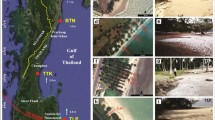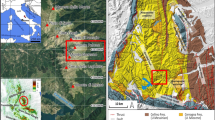Abstract
Three major dune-forming episodes are inferred in western parts of Rajasthan Desert. Massive and large-sized oldest dunes show crescentic, stabilised megabarchanoids or transverse, draas formed by stronger intensity southerly to southeasterly winds. These draas were transformed into linear and parabolic dunes through aeolian scouring and superimposed accretion of second and subsequent generations. The youngest aeolian reactivation here is represented by selective deflation and depositional linear arrays of active small barchans, vegetation-induced aeolian accumulations and prograding sand sheet Dune trends of younger-evolved forms suggest establishment of the southwesterly sand-moving wind circulation patterns during second-generation aeolian episode and its persistence of directional flows though with significantly lesser intensity into the contemporary wind regime in the area.
Similar content being viewed by others
References
Allchin, B, Goudie, A and Hegde, KMT (1978), The Prehistory and Palaeogeography of the Great Indian Desert. Academic Press, London 370 p.
Bakliwal, P C and Ramasamy, S M (1978). Lineament fabric of Rajasthan and Gujarat, India, Rec. Geol. Surv. India, 113 (7), 54–64.
Bakliwal, P C, Verma, R P and Grover, A K (1987). Geomorphological map of Rajasthan and Gujarat, Geol. Surv. India, Jaipur.
Bakliwal, P C and Grover, A K (1988). Signatures and migration of Saraswati river in Thar Desert, Western India, Rec. Geol. Surv. India, 116 (3–8), 77–86.
Biswas, S K (1987). Regional tectonic framework, structure and evolution of western marginal basins of India, Tectonophysics, 135, 307–327.
Breed, C S, Fryberger, S C, Andrews, S, Mc Cauley, C, Lennartz, F, Gebel, O and Horstman, K (1979). Regional studies on sand seas using Landsat (ERTS) imagery,In A Study of Global Sand Seas (E.D. Mc Kee,ed.) Castle House Pub., Kent, 305–397.
Chawla, S, Dhir, R P and Singhvi, A K (1992). Thermoluminescence chronology of sand profiles in the Thar Desert and their implications, Quaternary Science Reviews, 10, 25–32.
Cooke, R and Warren, A (1973). Geomorphology in Deserts, B.T. Batsford Ltd., London, 374 p.
Cooke, R, Warren, A and Goudie, A (1992). Desert Geomorphology, W.C.L. Press, London, 525 p.
Dharuman, R, Saxena, A K, Joshi, D D and Mulkh Raj (1992). Geological report on the Jaisalmer earthquake of 8th November, 1991, Geol. Surv. India, WR, Jaipur.
Dasgupta, S K (1975). A revision of Mesozoic Tertiary stratigraphy of the Jaisalmer basin, Rajasthan, India, Ind. Jour. Earth Sci., 2(1), 77–94.
Dhir, R P, Kar, A, Wadhawan, S K, Rajaguru, S N, Misra, V N, Singhvi, A K and Sharma, S B (1992). Thar Desert in Rajasthan - Land, Man and Environment, Geol. Soc of India, Bangalore, 191 p.
Goudie, A, Allchin, B and Hegde, K T M (1973). The former extensions of the Great Indian Sand Desert, Geogrl. J., 139, 243–257.
Kar, A (1987). Origin and transformation of Longitudinal sand dunes in the Indian Desert, Z. Geomorph., 31, 311–337.
Kar, A (1990). Megabarchanoids of the Thar - their environment, morphology and relationship with longitudinal dunes, Geogrl. J., 156, 51–61.
Kar, A (1993a). Aeolian processes and bedforms in the Thar Desert, J. Arid Environments, 25, 83–96.
Kar, A (1993b). Present day geomorphic processes - a key to the reconstruction of Quaternary landform history in the Thar Desert, J. Geol. Soc. India, 41, 513–517.
Lukose, N G (1974). Palynology of the subsurface sediments of Manhera Tibba structure, Jaisalmer, Western Rajasthan, India, The Palaeobotonist, 21, 285–297.
Lukose, N G (1977). Palynological evidences on climatic changes in Jaisalmer basin, Rajasthan,In Desertification and its control, Chap. No. 5, ICAR, Nairobi.
Mabbutt, J A (1977). Desert Landforms, Australian Nat. Univ., Canberra, 340 p.
Mc Kee, E Ded. (1979). A study of Global Sand Seas, USGS Prof. Paper 1052, U.S. Govt. Pub., Washington, 429 p.
Narayanan, K (1964). Problem of stratigraphy of the Rajasthan shelf, Proc. Symp. Problems of Indian Arid Zones, Govt, of India and UNESCO, CAZRL Jodhpur, 92–100.
Sharma, V K (1991). Geology and geomorphology of Quaternary deposits in parts of Jaisalmer district, Rajasthan,In Proc. Sem. Quaternary Landscapes of Indian Subcontinent, Baroda, 165–171.
Singh, S (1977). Sand dunes and palaeoclimate in Jodhpur district, western Rajasthan, Man and Environment, 1, 7–15.
Singh, S (1982). Types and formation of sand dunes in Rajasthan desert,In Sharma, H S (ed.) Perspectives in Geomiorphology, Concept Pub., New Delhi, 165–183.
Singh, N P (1982). Subsurface post-Eocene deposits of Jaisalmer basin, Rajasthan,In S S Merh (ed.) First National Seminar on Quaternary Environments, 1977, Hindustan Pub., Delhi, 234–243.
Verma, R P and Bakliwal, P C (1989). Use of remote sensing in desert classification and monitoring - an example from Thar Desert, India, Proc. Workshop on Arid Zone Research, AMU, Aligarh, 174–177.
Verstappen, H Th (1968). On the origin of longitudinal (seif) dunes, Z. Geomorph., 12, 200–220.
Verstappen, H Th (1970). Aeolian geomorphology of the Thar desert and palaeoclimates, Z. Geomorph., Suppl., 10, 104–120.
Wadhawan, S K (1968). Evolution of Quaternary aeolian deposits of Jodhpur and Banner districts, Rajasthan, India,In Proc. National Seminar, Recent Quaternary studies in India (M P Patel and N Desai,eds.). M S Univ., Baroda, 64–78.
Wadhawan, S K (1970). Quaternary aeolian stratigraphy and neotectonics in parts of Jaisalmer and Banner districts, Rajasthan and Banaskantha district, Gujarat, Rec. Geol. Surv. India, Jaipur, 122 (7), 16–17.
Wadhawan, S K (1991). Continental Neogene-Quaternary stratigraphy in arid-semiarid parts of Rajasthan, India,In Proc. Deptt. Sci. Tech. Workshop on Neogene-Quaternary Stratigraphy including the study of Fluvial and Glacial Systems, Univ of Delhi, 101–106.
Wadhawan, S K and Sural, Basudev (1992). Quaternary aeolian stratigraphy and neotectonics in Rajasthan and Gujarat, Rec. Geol. Surv. India, Jaipur, 125 (7).
Wasson, R J, Rajaguru, S N, Misra, V N, Agarwal, D P, Dhir, R P, Singhvi, A and Kameshwar Rao, K (1983). Geomorphology, Late Quateranary stratigraphy and palaeoclimatology of the Thar dunefields, Z. Geomorph., Suppl., 45, 117–151.
Wasson, R J and Hyde, R (1983). Factors determining desert dune type, Nature, 304, 337–339.
Author information
Authors and Affiliations
About this article
Cite this article
Wadhawan, S.K. Dune dynamics and evolution of aeolian landforms in parts of Jaisalmer district, Rajasthan, India. J Indian Soc Remote Sens 22, 65–77 (1994). https://doi.org/10.1007/BF03023876
Received:
Accepted:
Issue Date:
DOI: https://doi.org/10.1007/BF03023876




